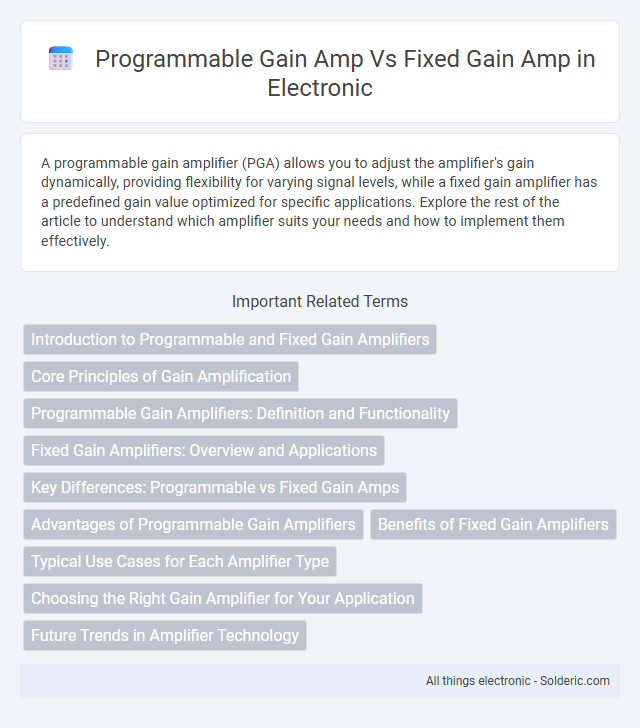A programmable gain amplifier (PGA) allows you to adjust the amplifier's gain dynamically, providing flexibility for varying signal levels, while a fixed gain amplifier has a predefined gain value optimized for specific applications. Explore the rest of the article to understand which amplifier suits your needs and how to implement them effectively.
Comparison Table
| Feature | Programmable Gain Amplifier (PGA) | Fixed Gain Amplifier (FGA) |
|---|---|---|
| Gain Adjustment | Variable gain controlled by digital or analog signals | Pre-set, constant gain value |
| Use Case | Dynamic signal conditioning and adaptable systems | Simple, stable amplification with fixed requirements |
| Complexity | Higher; requires control logic and additional components | Lower; straightforward design and implementation |
| Power Consumption | Typically higher due to added control circuitry | Lower, more efficient for static gain |
| Cost | Generally more expensive | Less expensive |
| Flexibility | High flexibility to adapt gain on-the-fly | Limited to fixed gain settings |
| Applications | Sensor interfaces, audio processing, adaptive control | Basic amplification, signal isolation |
Introduction to Programmable and Fixed Gain Amplifiers
Programmable gain amplifiers (PGAs) offer adjustable gain settings controlled via digital or analog inputs, enabling dynamic amplification tailored to varying signal conditions. Fixed gain amplifiers provide a constant gain value determined during design, ensuring simplicity and stability for applications with consistent signal requirements. PGAs are ideal for systems requiring flexibility and precision, while fixed gain amplifiers suit straightforward, low-noise amplification needs.
Core Principles of Gain Amplification
Programmable gain amplifiers (PGAs) allow dynamic adjustment of the gain through digital or analog control inputs, offering flexibility to optimize signal amplification based on varying input conditions. Fixed gain amplifiers maintain a constant gain value determined by their internal resistor network, providing simplicity and consistent performance for stable signal environments. Understanding these core principles helps you select the appropriate amplifier type to achieve precise signal conditioning tailored to your application's requirements.
Programmable Gain Amplifiers: Definition and Functionality
Programmable Gain Amplifiers (PGAs) are electronic amplifiers whose gain can be dynamically adjusted through external control signals, allowing precise amplification tailored to varying input signal levels. Unlike fixed gain amplifiers with predetermined amplification factors, PGAs enable real-time gain tuning, enhancing flexibility in signal conditioning and improving system performance in applications such as instrumentation, audio processing, and communication systems. This functionality supports optimized signal-to-noise ratios and prevents signal distortion by adapting the gain to the specific requirements of different input conditions.
Fixed Gain Amplifiers: Overview and Applications
Fixed gain amplifiers provide a constant, predetermined amplification level, offering simplicity and stability in signal processing applications. They are ideal for use in situations where the input signal amplitude is consistent, such as audio equipment, sensor signal conditioning, and communication devices. Your design benefits from fixed gain amplifiers when predictable gain performance and low noise are essential for reliable and accurate signal amplification.
Key Differences: Programmable vs Fixed Gain Amps
Programmable gain amplifiers (PGAs) allow you to adjust the gain dynamically through digital or analog control inputs, making them ideal for applications requiring variable signal amplification and flexibility. Fixed gain amplifiers provide a constant gain set at design time, offering simplicity and stability for situations where a predictable, unchanging gain is essential. The key difference lies in the adaptability of PGAs compared to the fixed, optimized performance of fixed gain amplifiers.
Advantages of Programmable Gain Amplifiers
Programmable Gain Amplifiers (PGAs) offer versatile gain control, allowing dynamic adjustment to optimize signal amplification in varying conditions without hardware changes. PGAs enhance system performance by accommodating a wide input signal range, reducing the need for external components and improving overall circuit flexibility. This adaptability is crucial in applications like sensor interfacing and audio processing, where signal amplitudes fluctuate significantly.
Benefits of Fixed Gain Amplifiers
Fixed gain amplifiers provide consistent and stable gain, ensuring predictable amplification essential for high-precision applications. Their simpler design reduces noise and distortion, improving signal integrity in audio and instrumentation systems. These amplifiers also offer cost-effective solutions with fewer components, enhancing reliability and ease of integration in embedded systems.
Typical Use Cases for Each Amplifier Type
Programmable gain amplifiers (PGAs) are ideal for applications requiring dynamic signal conditioning, such as audio processing, sensor signal amplification, and instrumentation systems where gain needs to be adjusted in real-time to accommodate varying input levels. Fixed gain amplifiers offer consistent and stable amplification, commonly used in RF communication circuits, audio devices with predefined volume settings, and measurement instruments requiring precise, unchanging gain. PGAs enhance flexibility in adaptive systems, while fixed gain amps provide reliability and simplicity for standardized signal amplification tasks.
Choosing the Right Gain Amplifier for Your Application
Choosing the right gain amplifier for your application depends on the required flexibility and precision; programmable gain amplifiers (PGAs) offer adjustable gain settings through digital control, making them ideal for dynamic signal environments. Fixed gain amplifiers provide a constant, predetermined gain value, ensuring simplicity and stability in applications where signal amplification requirements are consistent. You should consider factors like signal variability, design complexity, and cost when deciding between programmable gain amps and fixed gain amps.
Future Trends in Amplifier Technology
Programmable gain amplifiers (PGAs) are increasingly favored for their adaptability in dynamic signal environments, offering precise gain control through digital interfaces which supports advanced applications in IoT and AI-driven devices. Fixed gain amplifiers, while still prevalent for their simplicity and low noise performance, are gradually being integrated with programmable elements to enhance flexibility without compromising signal integrity. Emerging trends emphasize hybrid amplifier architectures combining fixed and programmable gain stages to optimize energy efficiency and signal fidelity in next-generation communication and sensor systems.
Programmable gain amp vs Fixed gain amp Infographic

 solderic.com
solderic.com